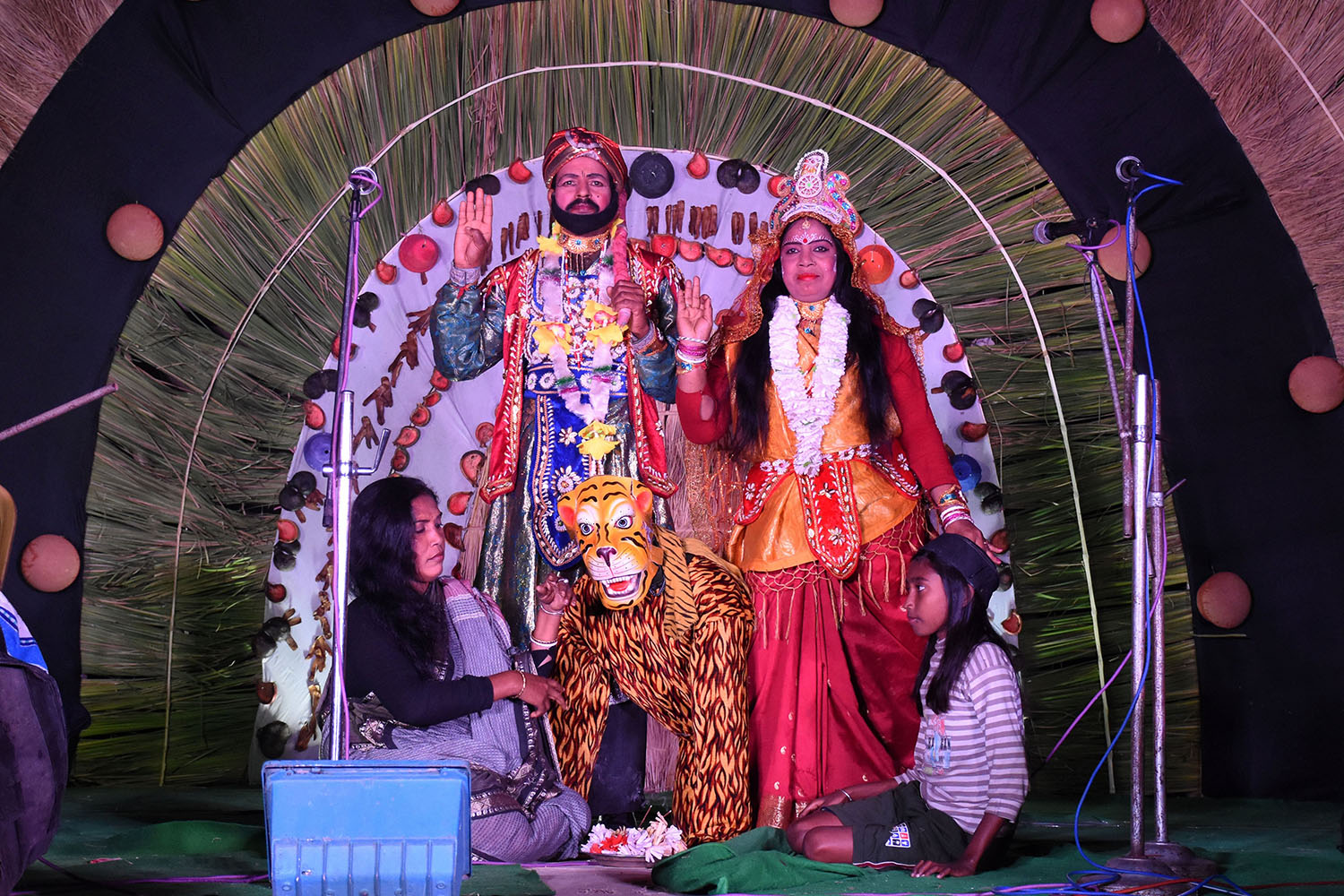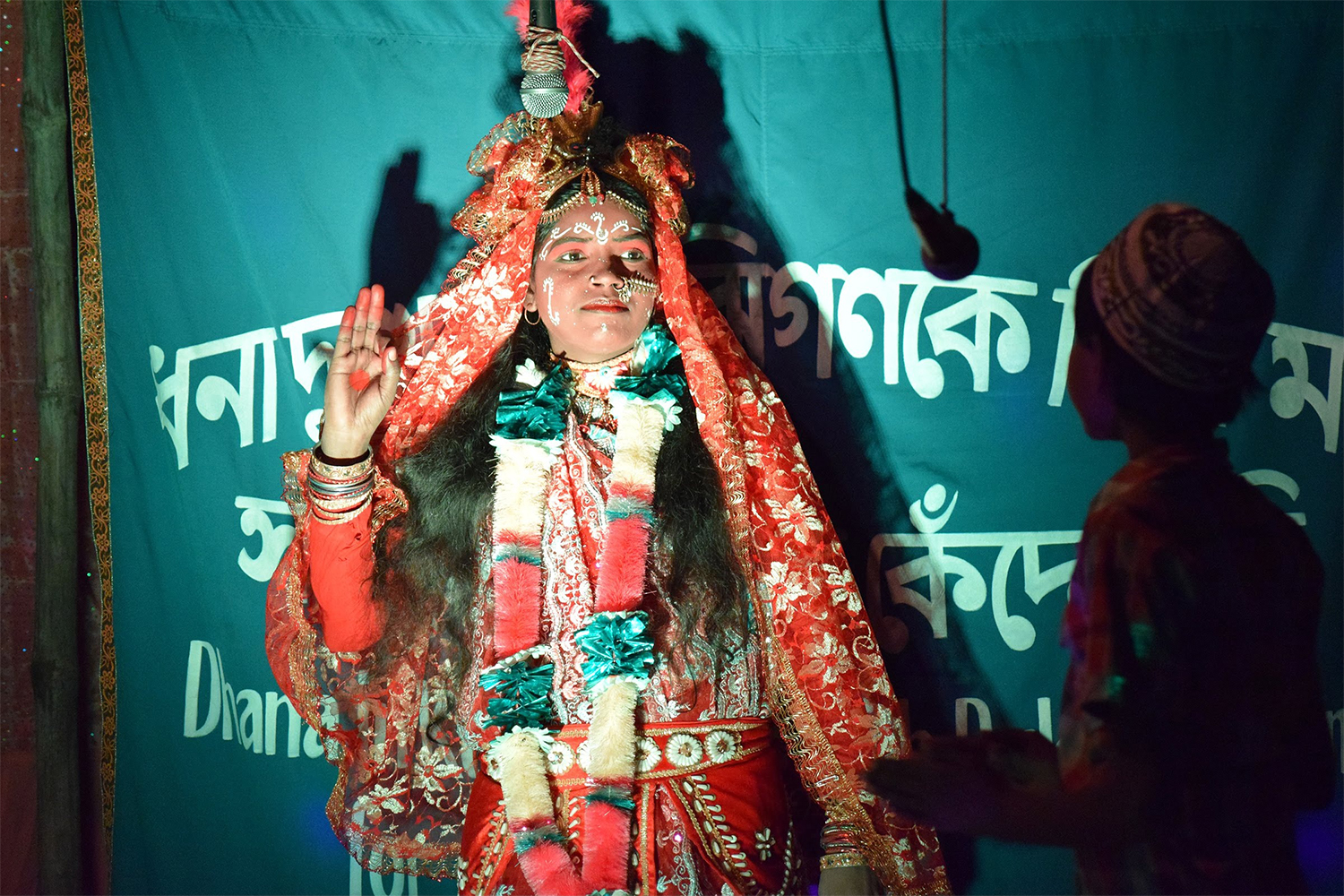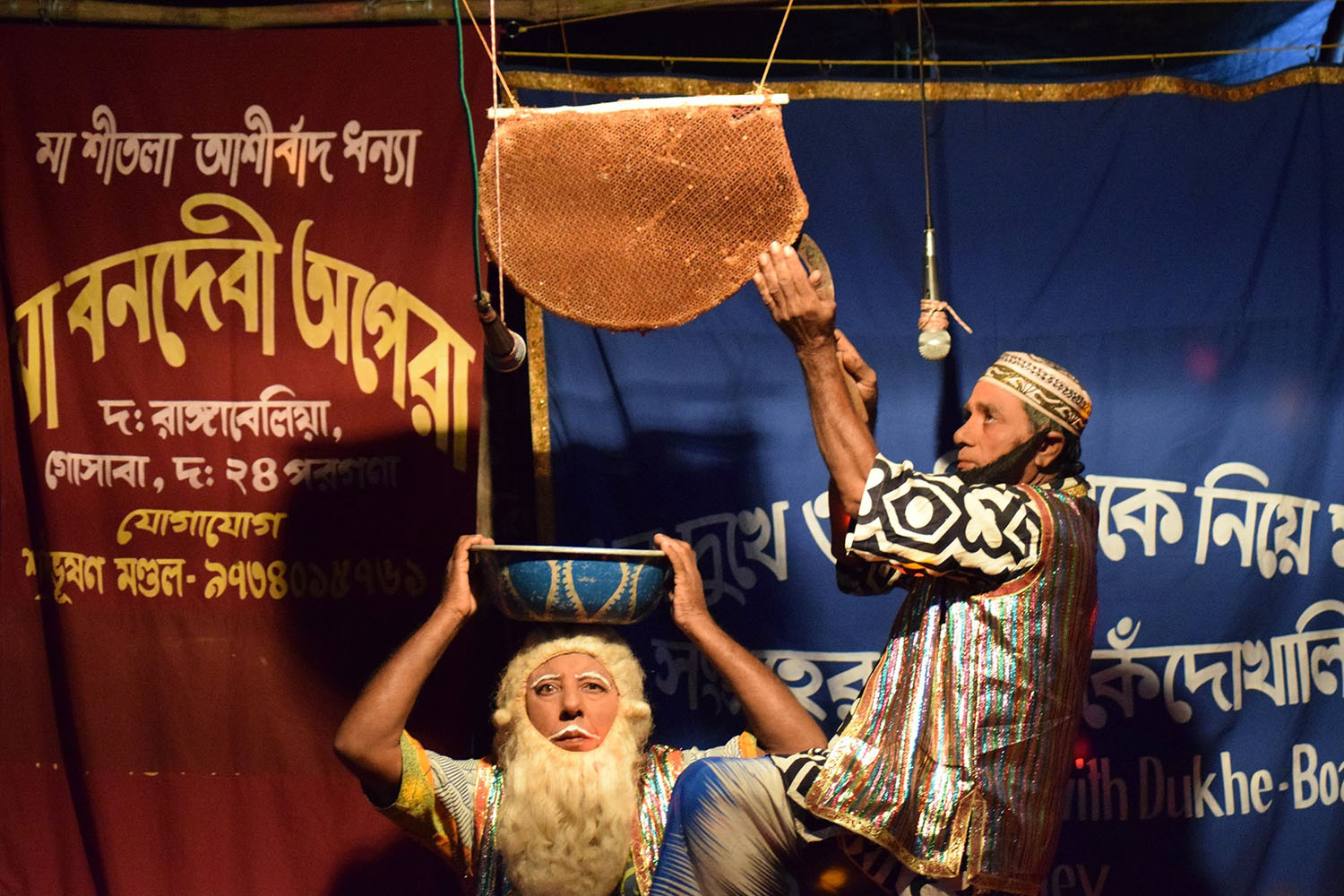ARTICLE
Bengali Jatra
A form of regional theatre performed primarily in the states of West Bengal and Odisha, jatra gained a performative form and popularity during the advent of Gaudiya Vaishnavism in fifteenth and sixteenth century Bengal. Bengali jatra palas (plays) were originally derived from Puranic and bhakti literature, before gradually adopting secular narratives and expanding into urban theatre. Combining elements of song and written dialogue, jatra incorporates bawdy humour and heroic escapades, accompanied with jatragan (Jatra songs).
Jatra is derived from the Sanskrit word yatra, which refers to a procession or journey. This is because the form was organised and conceived primarily as a travelling form of theatre, accompanying the pilgrimages of Krishna devotees. Although the pilgrimage season is between the months of September to late May or early June, jatra performances today take place throughout the year, often used as entertainment to mark festive occasions such as Durga Pujo.
Jatra performances take place in a circular space over which dhurries, carpets, tarp or canvas may be spread. The area is cordoned off with strings, and the audience is seated around this performance space. Although jatra was traditionally performed on flat ground, the use of raised platforms, artificial stage lights and suspended mics have increasingly become commonplace. The performance area is covered with a curtain which is pulled away once the performance starts; curtains are also dropped to signal changes in scenes.
The musicians accompanying the jatra are seated on one end of the space, with the actors occupying the centre. The instruments used include the khol (drum), kartal (cymbals), pakhwaj (double-sided drum), harmonium, clarinet and flutes. The prelude to a performance generally consists of musicians playing melodic ragas or popular songs to entertain and attract audiences, continuing for about an hour before the performance begins. Jatra performances employ improvisation, melodramatic acting and combative dialogue interspersed with dramatic segues. The passage of time and change of space is usually mentioned explicitly in dialogue and signalled by the dropping of curtains. Recurring character tropes in a jatra performance include the Badar (clown) and the Bibek (conscience), although the Bibek has largely disappeared from most modern Jatra performances.
The history of jatra is debated. Jatra-like performances are attested from the thirteenth century onwards in Odisha. However, these likely consisted only of diffused song and dance sequences interspersed with some narrative elements, unlike jatra which employs dialogue and longer narrative structures. Performance styles more similar to modern jatra crystallised during the growth of Gaudiya Vaishnavism in the late fifteenth century. Extant mangal-kavyas, long narrative poems with religious themes onwards, formed the basis of these jatra narratives. So too did the Gita-Govinda, a popular twelfth century text. Due to these Vaishnava influences, early jatra plays were preoccupied with Krishna bhakti, portraying episodes from the god’s life. This remained important in jatra even as it shifted its context to more secular settings. Popular performances in this genre include Divyon mada (The Divine Madness of Radha), Vichitravilasa (The Wonderful Joys of Radha and Krishna) and Ramavanavasa (The Exile of Rama).
By the eighteenth century, secular themes were being adopted by amateur jatra troupes, and these would eventually be incorporated by professional troupes as well. Bharatchandra Roy, who wrote the courtly romance Vidya-Sundar or Annada mangal in the late eighteenth century, is credited with popularising more diverse narratives within Jatra. Emerging from a courtly mangal-kavya, the narrative’s focus on sexuality and romance was popular with audiences. This led to other romantic epics such as Harishchandra and Nala Damayanti being portrayed in jatra. Public theatre, established in British-ruled late nineteenth century Calcutta (now Kolkata), led to jatra adopting European dramatic compositions and vice versa. The playwright Girish Chandra Ghosh introduced the Badar (clown) to jatra sequences, while Manmohan Basu borrowed elements of jatra in his theatrical works.
Jatra often incorporated bawdy themes, which were considered immoral by upper-class, upper-caste urban audiences. This led to a decline of its popularity in urban centres: although some musical and operatic performances borrowing from jatra remained popular on the Calcutta stage, jatra itself came to be performed primarily for rural audiences.
In the early twentieth century, jatra became an important tool in disseminating ideas widely. Playwrights such as Mukunda Das employed jatra during the Swadeshi movement, writing plays such as Matripuja (1905), Swadeshi Utsav (1906), and Rai Bahadur (1907). It would go on to become an important medium for political mobilisation, with the left-wing Indian People’s Theatre Association (IPTA) adopting Jatra in their performance Rahu-mukta (Freed From Eclipse) in 1954. The mid-twentieth century also saw women enter the Jatra stage, taking on roles which had hitherto been performed by men. These women were initially considered ‘immoral’ and in direct opposition to middle and upper class bhadralok women in Bengali society; such attitudes gradually changed as more women joined and even began to manage jatra troupes. Through much of the twentieth century, jatra competed for popularity with new and emergent forms of entertainment such as cinema, and the growing popularity of commercial theatre.
The 1960s saw the organisation of jatra festivals, which further popularised and institutionalised the form. Jatra performer Vidyabinode received the Sangeet Natak Akademi award in 1968, as did Surjya Kumar Dutta in 1976. These awards recognized the prominence of jatra amongst new audiences. Today, jatra remains a popular entertainment performed throughout the year, especially during celebratory events and jatra festivals in West Bengal.
Bibliography
Chatterjee, Minoti. “The Swadeshi Movement and Bengali Theatre.” Sangeet Natak no. 133-134 (1999): 33–56.
Ghose, Kalyani. “Jatra.” The Oxford Companion to Indian Theatre ed. Ananda Lal (New Delhi: Oxford University Press, 2004): 171–174.
Mukerjee, Amar. “Bengali Drama and Theatre.” Sangeet Natak 38, no. 2 (2004): 57–68.
Sarkar, Pabitra. “Jatra: The Popular Traditional Theatre of Bengal.” Journal of South Asian Literature 10, no. 2/4 (1975): 87–107. https://www.jstor.org/stable/40871932
Sen, Jasodhara. Conscience on Stage: Revisiting Jatra in Bengal as a Tool for Representation, Restoration and Revolution. PhD Dissertation. Boulder: University of Colorado, 2020.
Sen, Paromita. “The Man Who Would Be Rani.” The Telegraph. October 24, 2021. https://www.telegraphindia.com/culture/arts/the-man-who-would-be-rani/cid/1835685
Sen, Sotu. “Jatra – regional theatre of Bengal.” Sangeet Natak Akademi Bulletin no. 13-14 (October 1959): 19–20.









